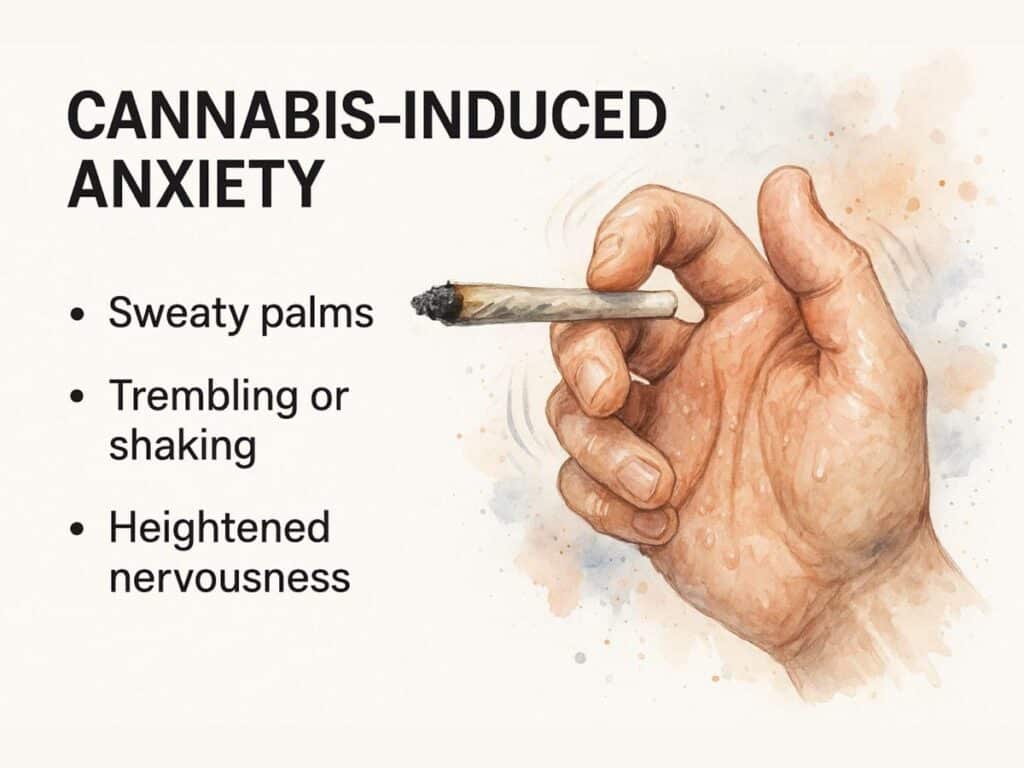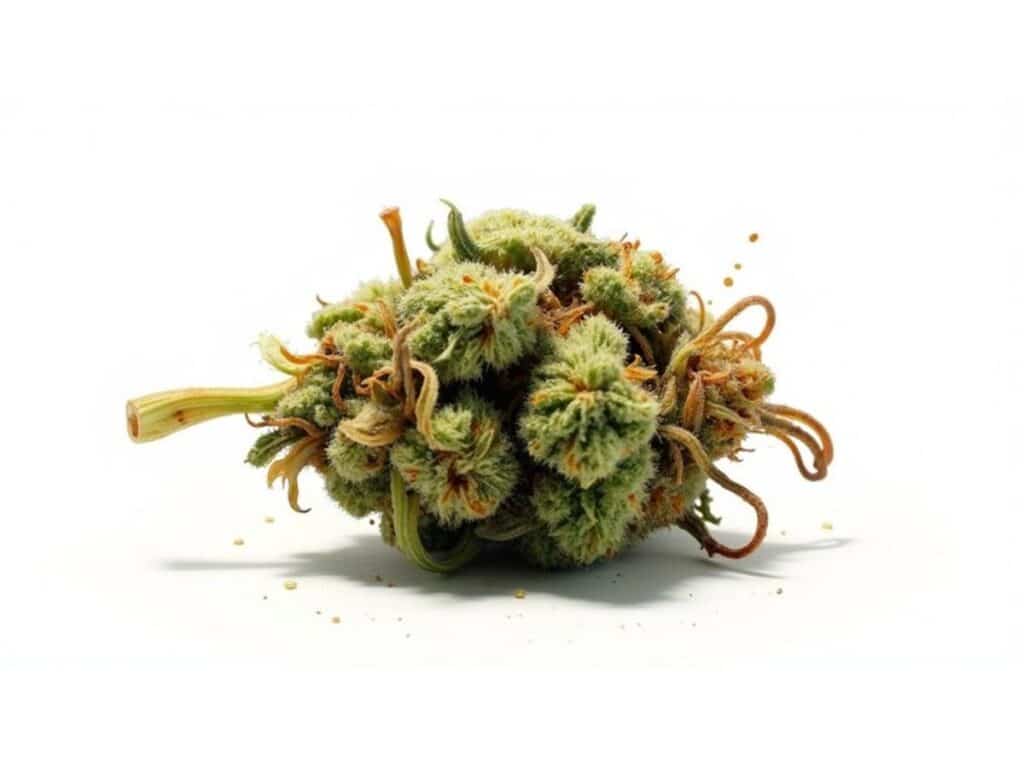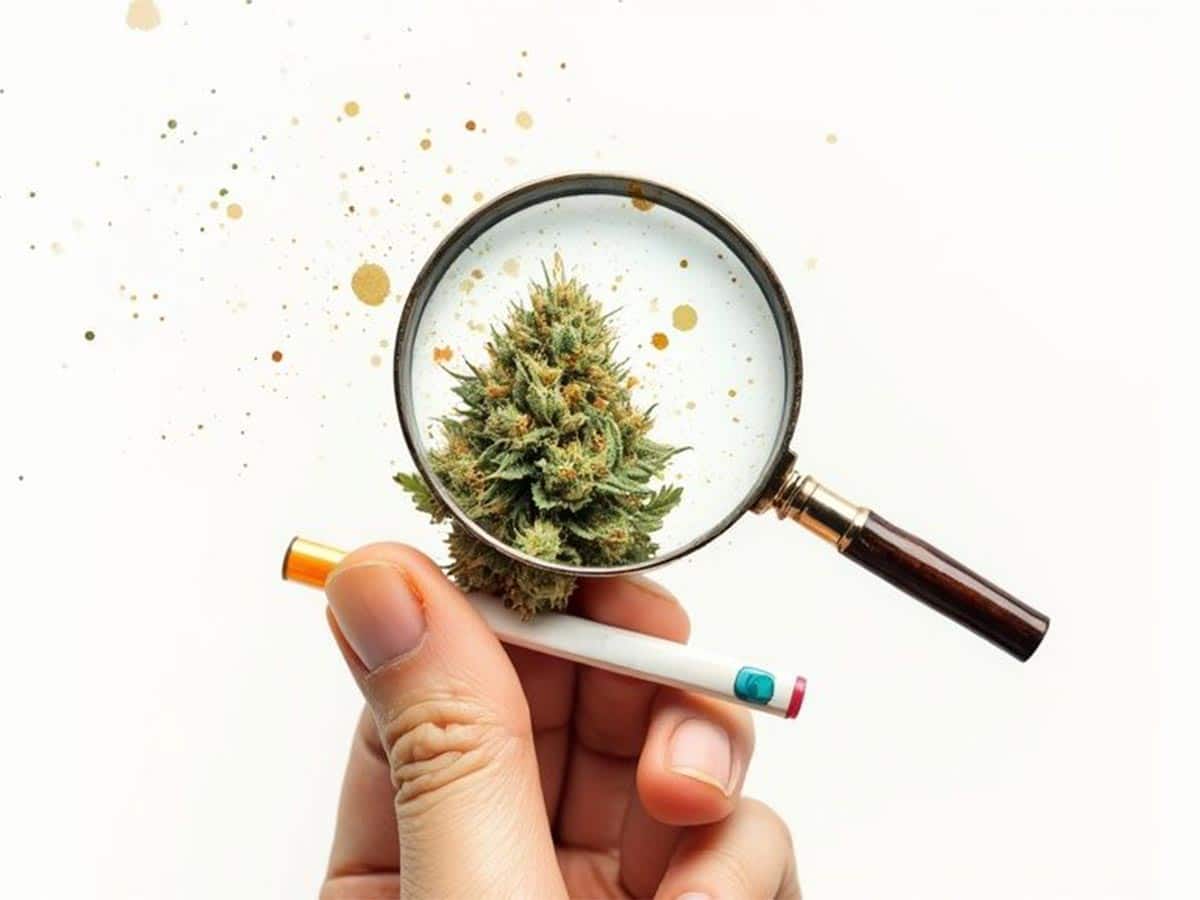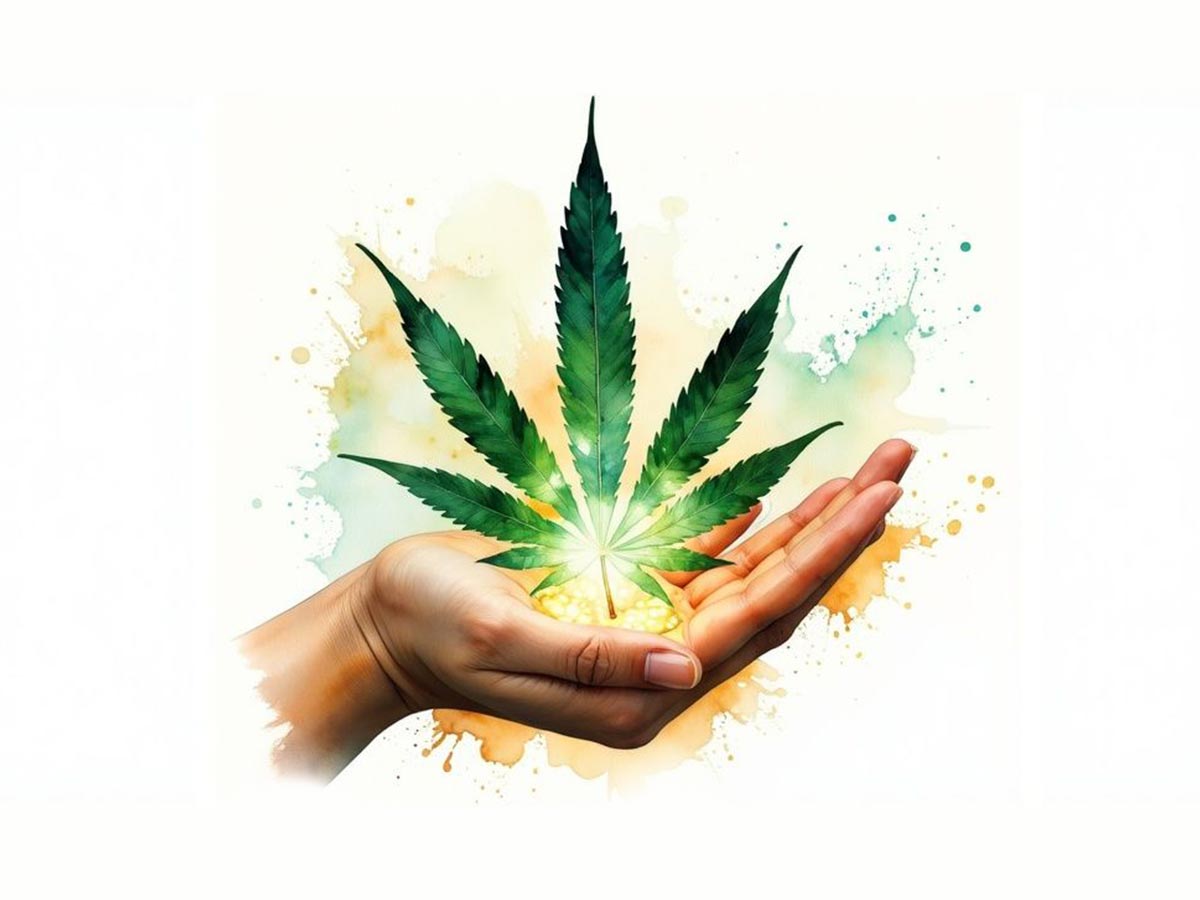Wondering how you know when weed is laced? The honest answer is it takes a sharp eye, a keen nose, and trusting your gut. You’re looking for anything that screams unnatural—from strange, powdery coatings and sharp, chemical smells to physical reactions that feel alarmingly different from a typical high.
Your first red flags are visual. A white powder that isn’t the plant’s natural, sparkly trichomes is a major warning. So is an acrid smell, like burnt plastic or cleaning supplies. But the most critical sign is how you feel. If you’re experiencing intense drowsiness, severe agitation, or hallucinations that are far beyond any high you’ve had before, your body is sounding the alarm.
Your Quick Guide to Spotting Laced Weed
Getting cannabis you’re unsure about can be unnerving. This guide isn’t here to scare you; it’s designed to arm you with practical knowledge so you can confidently identify potentially dangerous products. Learning to spot a few key differences is your best strategy for staying safe.
This infographic gives you a quick visual rundown of some immediate physical reactions—like tremors and sweating—that could signal your cannabis has been cut with something harmful.

As you can see, abnormal physical symptoms are often the most immediate and alarming signs of contamination. It is crucial to trust how your body feels. Your best defense begins with knowing what to look for, what to smell for, and even how the product burns. Think of these sensory checks as your first line of defense against a bad experience.
Telltale Signs to Watch For
The difference between clean cannabis and a contaminated product often comes down to small but significant details. Learning these indicators is an actionable skill that can make all the difference.
- Appearance: Natural cannabis has a familiar look—rich green and purple hues covered in tiny, sparkling crystals called trichomes. Laced weed, in contrast, might have an off-color powder dusted on it, visible crystals that look like salt, or an unusual oily sheen. For example, a bud that looks like it’s been rolled in fine sugar isn’t natural.
- Smell: High-quality cannabis has a distinct earthy, skunky, or citrus aroma. If you smell something sharp and chemical—like paint thinner, acetone, or burning plastic—that’s a massive red flag. Trust your nose; if it smells wrong, it probably is.
- Burn Test: When you burn natural cannabis, it produces a grayish-white ash. If the ash is hard, black, and doesn’t burn properly, or if you notice colored smoke or sparks, it’s a strong sign it’s been contaminated. Imagine lighting a piece of paper versus a piece of plastic; the difference in smoke and residue tells you a lot.
The DEA has indicated that drug mixtures, including cannabis laced with potent substances like fentanyl, are a growing concern. This reality makes a quick visual and sensory inspection more critical than ever for your personal safety.
A quick comparison chart can help solidify these distinctions.
Natural vs. Potentially Laced Cannabis At a Glance
Use this simple table as a quick reference to compare what’s normal against what’s a potential warning sign.
| Indicator | Natural Cannabis | Potentially Laced Cannabis |
|---|---|---|
| Look | Green/purple hues, natural trichomes | Powdery residue, oily sheen, unusual crystals |
| Smell | Earthy, skunky, pine, or citrus aromas | Chemical, plastic, or solvent-like odors |
| Taste | Herbal and earthy flavor profile | Harsh, metallic, or chemical taste |
| Burn | Grayish-white, soft ash | Hard, black ash; may spark or produce colored smoke |
| Feel | Slightly sticky from resin | Overly sticky, wet, or unusually dry and brittle |
Ultimately, this checklist gives you actionable steps to vet your product. If something seems off in any of these areas, always err on the side of caution. While no single sign is definitive proof, a combination of these red flags should be taken seriously.
Decoding Visual and Sensory Red Flags
Think of your senses as your first line of defense. Before you ever consume a product, your eyes, nose, and even your sense of touch can provide critical clues about its purity. Learning to trust these instincts is the most immediate, actionable step you can take to figure out how you know when weed is laced. It’s all about spotting the details that feel wrong.
This process starts with a simple visual inspection under good light. Natural cannabis has a look you get used to, but contaminants almost always leave tell-tale signs that don’t belong.

What to Look For
First, get the bud under a good light. Natural flower is covered in trichomes—the plant’s tiny, crystal-like resin glands that give it that familiar sparkle. Lacing agents, however, look completely out of place.
- Unnatural Powders or Crystals: Look for a fine, white, or off-color powder that appears dusted on top. A practical example would be a coating that looks like salt or baking soda, which could be a sign of fentanyl.
- Glassy Shards: See small, shiny, or glass-like fragments mixed in? This is a huge warning sign and could point to methamphetamine.
- Sugary or Oily Coating: If the bud has a strange, wet sheen or a coating that looks like it was dipped in sugar water, it suggests an additive was sprayed on to add weight or mimic high-quality resin.
Many people mistake any crystal for a natural trichome. But here’s a practical tip: adulterants often look like a separate layer of material you could brush off. The plant’s own resin glands are integrated and won’t flake away so easily.
The Smell and Burn Test
After a thorough visual check, your nose is your next best tool. Cannabis is famous for its complex aromas, which come from compounds called terpenes. These are what make it smell earthy, piney, citrusy, or floral.
Contaminated weed often smells jarringly different. A sharp, chemical odor—like paint thinner or nail polish remover—is a clear signal to stay away. Trust your gut; if it smells wrong, it is wrong.
Finally, the burn test can offer more clues. While not foolproof, it’s a useful observation.
The Burn Test Explained:
- Observe the Flame: Light a tiny piece and watch for anything unusual. Sparks, crackling sounds (like a sparkler), or a flame that burns with a strange color can indicate chemical accelerants.
- Check the Smoke: The smoke should be white or light gray. If it’s thick and black, or has a blue or purple tint, something other than cannabis is burning.
- Inspect the Ash: Natural cannabis typically burns down to a soft, grayish-white ash. If the ash is hard, black, and oily, it’s a strong indicator of contaminants that aren’t combusting cleanly. According to Wikipedia, the color and consistency of ash are directly related to the material being burned, making this a useful (though not conclusive) observation.
While no single sensory check is 100% foolproof, combining these observations creates a powerful, multi-layered screening process. If the cannabis fails any of these simple tests, the safest choice is to avoid it. Your safety is always the top priority.
Recognizing Dangerously Different Effects
Sometimes, the clearest sign that something is wrong isn’t what you see or smell—it’s how you feel. If you’re a regular cannabis user, you have a baseline for what a typical high feels like. Laced weed, however, can produce effects that are not just intense, but dangerously unfamiliar.
Think of it as your body’s built-in alarm system. If the experience feels intensely distressing or physically wrong in a way that’s completely out of character for cannabis, that’s a massive red flag. You need to act on that signal.

Unpredictable Highs from Synthetic Cannabinoids
One of the most common—and frightening—adulterants are synthetic cannabinoids. These lab-made chemicals mimic THC but bind to your brain’s receptors far more aggressively. The result isn’t just a stronger high; it’s a wildly unpredictable and often terrifying ordeal.
Just how common is this? Seized samples tested between 2020 and mid-2021 revealed that a powerful synthetic known as MDMB-4en-PINACA was found in about 40% of adulterated cannabis products. To make matters worse, some samples contained a cocktail of up to three different synthetics, explaining why reactions can be so erratic and severe.
Watch for these alarming symptoms:
- Intense Paranoia and Anxiety: Not just mild unease, but a full-blown, overwhelming panic attack.
- Vivid Hallucinations: Seeing or hearing things that aren’t there is not a typical effect of natural cannabis.
- Rapid Heartbeat and Chest Pains: A heart pounding out of your chest or causing pain is a serious medical warning.
- Seizures or Uncontrollable Shaking: These are signs of a severe neurological reaction requiring immediate medical help.
Signs of Opioid or Stimulant Lacing
While synthetics are a huge problem, other drugs can also be secretly mixed into cannabis. Knowing the distinct symptoms of these substances can help you identify the danger and react quickly.
A normal cannabis high might leave you feeling relaxed or euphoric. It shouldn’t feel like your body is shutting down or spiraling into a medical crisis. If the effects are closer to an emergency than a high, you must treat it like one.
Opioid (like Fentanyl) Lacing Symptoms:
- Extreme drowsiness or “nodding off”
- Dangerously slow or shallow breathing
- Pupils constricted to tiny pinpoints
- Cold, clammy skin
Stimulant (like Methamphetamine) Lacing Symptoms:
- Extreme hyperactivity and agitation
- Uncharacteristic, aggressive behavior
- Profuse sweating
- Severe paranoia and anxiety
If the anxiety you’re feeling is off the charts, take it seriously. For those who already manage anxiety, knowing your baseline is key. Learning about the best cannabis strains for anxiety can give you a better idea of what a controlled, therapeutic experience should feel like. If you ever suspect you’ve consumed a laced product, don’t hesitate. Your top priority is to get help—call for emergency medical assistance right away.
The Invisible Threat: Synthetic Adulterants
The game has changed. While many people still picture laced weed as something mixed with obvious powders, today’s biggest threat is often completely invisible: synthetic cannabinoids. This dangerous class of lab-made chemicals presents a deceptive and serious risk.
These aren’t just stronger versions of THC; they’re entirely different substances. Illicit producers spray these chemicals onto plain herbs or low-grade cannabis to fake the effects of the real thing. The problem? They are wildly more potent and dangerously unpredictable.
Think of it like this: THC fits into your brain’s cannabinoid receptors like a key designed for a specific lock. Synthetic cannabinoids are like crude master keys that jam the lock and force it open, causing unpredictable and harmful results.
A Growing Global Problem
This isn’t just a local issue—it’s a global one. The practice of lacing cannabis with synthetic cannabinoid receptor agonists (SCRAs) is frighteningly common. For example, between 2020 and 2021, countries across Europe, including Sweden, Germany, and France, reported seizing cannabis products contaminated with these chemicals.
The most common culprits were substances with complex names like 5F-MDMB-PICA and MDMB-4en-PINACA—chemicals designed specifically to fool users while posing serious health risks. The United Nations Office on Drugs and Crime published a full report on these findings that pulls back the curtain on the true scale of the issue.
This data drives home a critical point: the danger isn’t just about obvious white powders anymore. It’s about invisible, odorless chemicals created to infiltrate the cannabis supply, trick consumers, and put them in harm’s way.
With the rise of synthetic adulterants, a simple visual or smell check is no longer enough. A perfectly normal-looking bud could be coated in a potent chemical you’d never detect on your own.
Why Synthetics Are So Deceptive
So, why are these synthetics being used? It’s all about profit. They’re cheap to produce and can make low-quality weed seem extremely potent, duping people into thinking they’ve bought a top-shelf product. This deception makes identifying contaminated cannabis a serious challenge.
Here’s what makes them so dangerous:
- Extreme Potency: Some synthetics can be up to 100 times stronger than natural THC, leading to overwhelming and sometimes life-threatening effects.
- Unpredictable Reactions: Cooked up in unregulated labs, their chemical makeup is inconsistent, causing wildly different reactions from one person to the next.
- Invisible by Design: Most are sprayed on as a clear, odorless liquid, leaving no obvious signs. You can’t see them, and you can’t smell them.
This new reality makes sourcing your cannabis from a trusted supplier more important than ever. When the threat is invisible, your best defense is knowing your product comes from a regulated source that provides professional testing for purity and safety.
How to Reliably Test for Contaminants
Trusting your senses is a good first line of defense, but what about contaminants you can’t see, smell, or taste? For true peace of mind, you need to test your product. Thankfully, accessible tools can give you a clear answer.
The single most important tool for consumer safety right now is the fentanyl test strip. With fentanyl appearing in unexpected places, these simple strips have become a critical harm-reduction tool. They’re easy to use and provide a straight yes-or-no answer on whether fentanyl is present.
Using Fentanyl Test Strips Correctly
Getting an accurate reading is all about following the steps correctly. You can’t just rub a strip on a nug—you have to create a solution to test it properly.
Here’s a step-by-step, actionable guide:
- Prep the Sample: Take a tiny piece of the cannabis—about 10mg, roughly the size of a match head. Place it in a clean container like a small plastic bag or bottle cap.
- Add Water: Add a small amount of clean water, about half a teaspoon, to dissolve any potential contaminants.
- Mix Thoroughly: Swirl or stir the mixture for at least 60 seconds. The goal is to get any fentanyl present to dissolve into the water.
- Dip the Strip: Hold the fentanyl test strip by the solid blue end and dip the wavy end into the water for about 15 seconds. Do not submerge it past the max line.
- Read the Results: Lay the strip on a flat, clean surface. After a minute or two, lines will appear. Two lines mean it’s negative (no fentanyl detected). One line means it’s positive (fentanyl detected).
A single line is a positive result, and that means danger. It might seem counterintuitive, but remember this simple rule: one line means stop. If you see a single line, that cannabis is unsafe and should be disposed of immediately.
Beyond Fentanyl Test Strips
Fentanyl is a major concern, but it’s not the only potential contaminant. While other kits exist to screen for substances like synthetic cannabinoids (Spice/K2), they can be harder to find and may not be as reliable.
When it comes down to it, nothing beats professional lab testing for total assurance.
Licensed dispensaries are required to use certified labs to test their products for a full panel of contaminants, from pesticides and heavy metals to other adulterants. This is the gold standard for safety. If you’re serious about knowing exactly what’s in your product, understanding the entire cultivation process is a game-changer. Our guide on how to grow cannabis from seeds offers a great look into what a clean, controlled grow operation involves.
Ultimately, testing puts the power back in your hands. Whether you’re using a simple fentanyl strip or buying from a dispensary that provides lab results, that extra step is the best way to ensure your cannabis is safe.
Your Best Defense Is a Trusted Source
At the end of the day, the most effective way to deal with laced weed is to ensure it never gets near you in the first place. Smell tests and fentanyl strips are valuable tools, but they are a last line of defense. Your real power lies in where you source your cannabis.
The safety gap between the legal, regulated market and the illicit street market is massive. Choosing your supplier is the single most important decision you can make.
Buying from a licensed dispensary provides a safety net the black market simply cannot offer. These businesses must adhere to strict regulations, which includes sending every product to a professional lab for testing. Everything on their shelves has been screened for pesticides, heavy metals, and the dangerous cutting agents we’ve discussed.
The Dangers of the Unregulated Market
The street market is a total crapshoot. There’s no regulation, no testing, and products are often handled in places where cross-contamination is a real risk. The data paints a grim picture.
One long-term study examining illicit cannabis samples found that a staggering 42.5% contained no natural cannabinoids at all—they were completely fake. Even more frightening, 38.17% were laced with some kind of psychoactive substance, most often synthetic cannabinoids. You can dig into the specifics by reading the published research from the WEDINOS project.
Let that sink in. When you buy from an unregulated source, you’re taking a very real risk on getting something that’s either totally fake or dangerously contaminated. It’s a gamble that just isn’t worth taking.
Harm Reduction in Higher-Risk Scenarios
We get it—not everyone lives where legal dispensaries are accessible. If you find yourself in that situation, harm reduction becomes your primary strategy.
If you absolutely must use a product from an untrusted source, please do not do it alone. And always, always start with a tiny amount—far smaller than your usual dose—to gauge your reaction before considering more.
Another small but vital step is proper storage to prevent accidental contamination after purchase. Knowing about the best cannabis storage containers is a simple way to add another layer of safety. By sticking with trusted sources and always being cautious, you stay in control and dramatically reduce your risk.
Got Questions About Laced Weed? We’ve Got Answers.
When you’re trying to stay safe, it’s natural to have questions about contaminated cannabis. Getting straight, honest answers is the first step toward making smarter choices. Let’s tackle some of the most common concerns.
Can You Tell If Weed Is Laced Just by Smelling It?
Honestly, probably not. While a harsh, chemical-like smell is a major red flag, it’s far from a reliable test. Many modern adulterants, especially synthetic cannabinoids, are designed to be odorless. Their scent can also be easily masked by the natural aroma of the cannabis.
Think of the smell test as just one piece of the puzzle. It’s an important check, but you can’t rely on it alone. For true confidence, combine sensory checks with smarter sourcing strategies.
What Is Weed Most Commonly Laced With?
While stories about fentanyl grab headlines, the data points elsewhere. According to global drug monitoring agencies, the most widespread adulterants are actually synthetic cannabinoid receptor agonists (SCRAs). These are especially common in unregulated markets.
These aren’t just a different type of weed—they are powerful, lab-made chemicals designed to imitate THC, but they’re incredibly unpredictable and far stronger. The fact that they’re so common is a huge reason why a simple look or sniff test is no longer enough.
What Should I Do If I Think I’ve Used Laced Weed?
Your absolute first priority is safety. If you or someone you’re with shows severe symptoms—like difficulty breathing, seizures, extreme paranoia, or loss of consciousness—call for emergency medical help immediately. Do not hesitate or wait for it to get better on its own.
When help arrives, be honest about what was taken. Medical professionals are there to help, not to get you in trouble. Giving them the full story is the only way they can provide the right life-saving treatment.
At Elevation Headquarters, your safety and satisfaction are our top priorities. We offer a curated menu of lab-tested cannabis products, from premium flower to edibles and concentrates, so you can feel confident you’re getting a pure, consistent experience every time. Eliminate the guesswork and enjoy the peace of mind that comes from using products you can trust. Explore our collection at https://elevationhqnyc.com/store.



